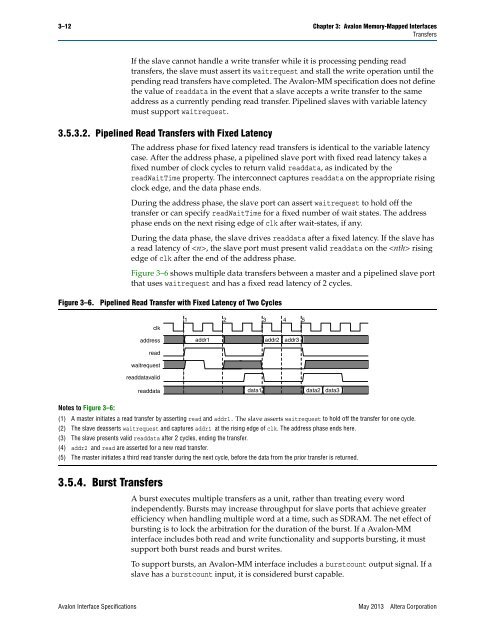Avalon Interface Specifications (PDF) - Altera
Avalon Interface Specifications (PDF) - Altera
Avalon Interface Specifications (PDF) - Altera
You also want an ePaper? Increase the reach of your titles
YUMPU automatically turns print PDFs into web optimized ePapers that Google loves.
3–12 Chapter 3: <strong>Avalon</strong> Memory-Mapped <strong>Interface</strong>s<br />
Transfers<br />
If the slave cannot handle a write transfer while it is processing pending read<br />
transfers, the slave must assert its waitrequest and stall the write operation until the<br />
pending read transfers have completed. The <strong>Avalon</strong>-MM specification does not define<br />
the value of readdata in the event that a slave accepts a write transfer to the same<br />
address as a currently pending read transfer. Pipelined slaves with variable latency<br />
must support waitrequest.<br />
3.5.3.2. Pipelined Read Transfers with Fixed Latency<br />
3.5.4. Burst Transfers<br />
The address phase for fixed latency read transfers is identical to the variable latency<br />
case. After the address phase, a pipelined slave port with fixed read latency takes a<br />
fixed number of clock cycles to return valid readdata, as indicated by the<br />
readWaitTime property. The interconnect captures readdata on the appropriate rising<br />
clock edge, and the data phase ends.<br />
During the address phase, the slave port can assert waitrequest to hold off the<br />
transfer or can specify readWaitTime for a fixed number of wait states. The address<br />
phase ends on the next rising edge of clk after wait-states, if any.<br />
During the data phase, the slave drives readdata after a fixed latency. If the slave has<br />
a read latency of , the slave port must present valid readdata on the rising<br />
edge of clk after the end of the address phase.<br />
Figure 3–6 shows multiple data transfers between a master and a pipelined slave port<br />
that uses waitrequest and has a fixed read latency of 2 cycles.<br />
Figure 3–6. Pipelined Read Transfer with Fixed Latency of Two Cycles<br />
Notes to Figure 3–6:<br />
clk<br />
address<br />
read<br />
waitrequest<br />
readdatavalid<br />
readdata<br />
1 2 3 4 5<br />
addr1 addr2 addr3<br />
data1 data2 data3<br />
(1) A master initiates a read transfer by asserting read and addr1. The slave asserts waitrequest to hold off the transfer for one cycle.<br />
(2) The slave deasserts waitrequest and captures addr1 at the rising edge of clk. The address phase ends here.<br />
(3) The slave presents valid readdata after 2 cycles, ending the transfer.<br />
(4) addr2 and read are asserted for a new read transfer.<br />
(5) The master initiates a third read transfer during the next cycle, before the data from the prior transfer is returned.<br />
A burst executes multiple transfers as a unit, rather than treating every word<br />
independently. Bursts may increase throughput for slave ports that achieve greater<br />
efficiency when handling multiple word at a time, such as SDRAM. The net effect of<br />
bursting is to lock the arbitration for the duration of the burst. If a <strong>Avalon</strong>-MM<br />
interface includes both read and write functionality and supports bursting, it must<br />
support both burst reads and burst writes.<br />
To support bursts, an <strong>Avalon</strong>-MM interface includes a burstcount output signal. If a<br />
slave has a burstcount input, it is considered burst capable.<br />
<strong>Avalon</strong> <strong>Interface</strong> <strong>Specifications</strong> May 2013 <strong>Altera</strong> Corporation
















